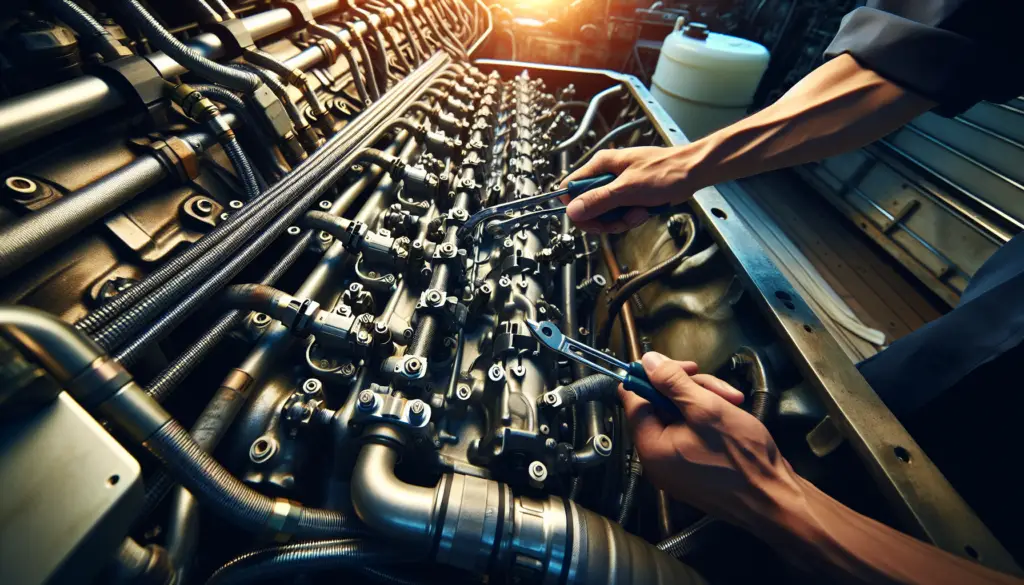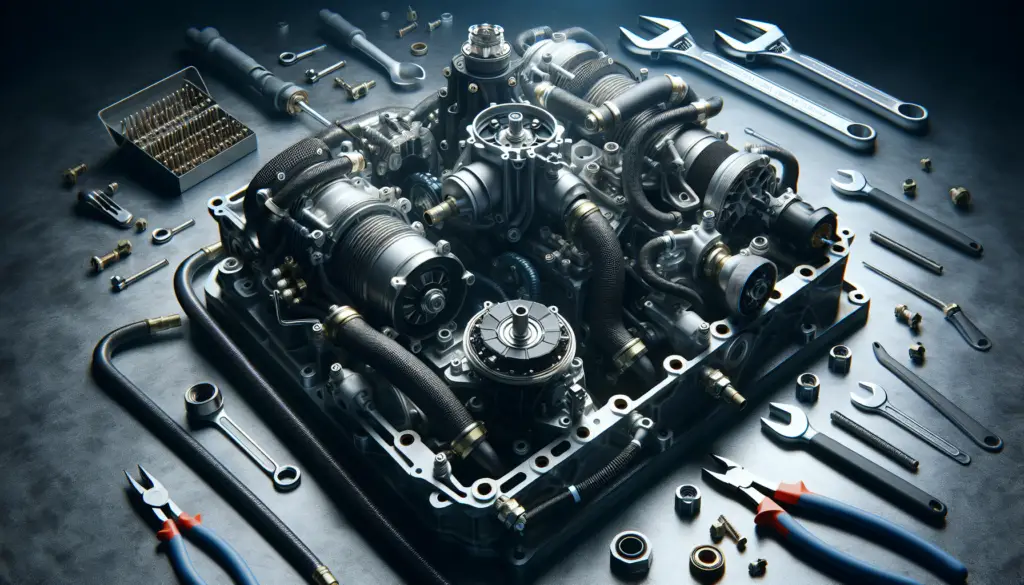Set sail with confidence knowing your boat’s engine cooling system is in top shape! In the article “How To Properly Service Your Boat Engine’s Cooling System,” you’ll find everything you need to keep your aquatic adventures smooth and trouble-free. Become the master of your own vessel by learning how to maintain, troubleshoot, and resolve any issues that could potentially affect your boat’s cooling system.阝

Understand the Types of Boat Engine Cooling Systems
When it comes to boat engine cooling systems, it’s critical to understand the different types that are available. This understanding will guide you in making the right maintenance decisions that will help extend the lifespan of your boat’s engine. There are primarily three types of boat engine cooling systems: closed cooling systems, raw water cooling systems, and hybrid cooling systems.
Closed Cooling System
A closed cooling system operates in a similar way as a car’s cooling system. Here, the engine is cooled by a coolant that recirculates within the engine. By using a heat exchanger, the heat from the coolant is transferred to the outside environment, usually water. This system is advantageous as it reduces the risk of internal engine parts being corroded by outside water, especially saltwater.
Raw Water Cooling System
In contrast to closed cooling systems, raw water cooling systems utilise the outside water to directly cool the engine. This system draws in surrounding water, passes it through the engine to absorb heat, and then expels it back out. While this system is simpler and cheaper than a closed cooling system, it exposes the internal parts of the engine to potential corrosion from salt or debris in the water.
Hybrid Cooling System
A hybrid cooling system combines the benefits of both a closed cooling system and a raw water cooling system. It has two cycles, with one using a coolant to keep the engine cool and another using outside water to cool the heat exchanger, which in turn cools the coolant. As with the closed cooling system, the hybrid system reduces the risk of internal engine corrosion.
Importance of Regular Servicing of the Boat’s Cooling System
Regular maintenance of your boat’s cooling system is essential for several reasons. They range from preventing overheating to ensuring proper functioning and increasing the lifespan of the engine.
Preventing Overheating
One of the primary reasons for regular servicing of your boat’s engine cooling system is to prevent overheating. Overheating can result from blocked coolant passages, a malfunctioning water pump, or thermostat problems. These issues can lead to severe engine damage if left unattended.
Ensuring Proper Functioning
Just as with any mechanical system, your boat’s cooling system needs regular servicing to continue functioning optimally. Regular checks and cleaning can help detect early signs of problems that could eventually lead to system failure if not addressed.
Increasing Lifespan of the Engine
A properly functioning cooling system plays a significant role in increasing the lifespan of your boat’s engine. A well-serviced cooling system ensures that the engine operates within the right temperature range, thus reducing wear and tear.
Avoiding Unexpected Breakdowns
Lastly, regular maintenance helps to avoid unexpected breakdowns which can lead to costly repairs and inconveniences while out at sea. By identifying potential problems early, you can make necessary repairs before they become significant issues.
Understanding the Components of the Boat’s Cooling System
The cooling system of a boat engine consists of several components, each serving a unique function. Let’s delve into what each part does.
Water Pumps
In a boat’s engine cooling system, the water pump plays the vital role of distributing the coolant through the engine. Whether it’s a closed or raw water system, the water pump ensures the coolant circulates appropriately to absorb and dissipate heat from the engine.
Heat Exchanger
The heat exchanger is a crucial component of a closed or hybrid cooling system. It serves the purpose of transferring heat from the coolant to the outside water, thus cooling the coolant which then travels back to absorb more heat from the engine.
Thermostat
The thermostat in your boat engine’s cooling system regulates the temperature of the engine by controlling the flow of coolant based on the engine’s temperature. It ensures the engine doesn’t get too hot or too cold, which can lead to problems.
Radiator
While radiator systems are more common in cars, some boats may use a keel cooler, a kind of radiator, instead of a raw water intake system. Radiators work by cooling the engine coolant as it passes through tubes, which are then cooled by the air.
Pre-Service Safety Measures
Before you begin working on your boat’s cooling system, several safety measures should be in place. Skipping these could lead to harm or damage to the boat.
Ensure the Engine is at Rest
Always make sure that the boat’s engine is off and cool before you perform any servicing work on it. This prevents accidents from moving parts and also helps avoid burns from hot components.
Disconnect the Power
Disconnect all power sources before you start working on your boat’s engine. This significantly lowers the possibilities of electric shock, especially when working with water.
Wear Suitable Protective Gear
Prepare yourself with suitable protective gear. This may include gloves to protect your hands, safety glasses to protect your eyes from any splashes, and maybe even overalls to keep your clothes clean.

Steps to Service Your Boat Engine’s Cooling System
If the thought of servicing your boat engine’s cooling system seems daunting, don’t worry. By breaking it down into manageable steps, the process becomes easier and less intimidating.
Drain the Coolant
The first step is to drain the coolant from your boat’s engine. Use a drain pan to collect the coolant to prevent spilling this toxic substance into the environment.
Check and Clean Components
After draining the coolant, check the exposed components. Look for signs of corrosion, leaks, or any irregularities. Use an appropriate cleaning tool or solution to clean the necessary parts.
Refill the Coolant
After inspecting and cleaning the components, refill the cooling system with new coolant. Remember to use the correct type and amount of coolant as recommended by your boat’s manufacturer.
Bleed the System
Bleeding the system means getting rid of any air that might have entered the cooling system during the servicing. Since air pockets can become hotspots and lead to overheating, ensure you bleed the system after refilling the coolant.
Checking and Replacing the Water Pump
One of the main components that require your attention during servicing is the water pump. From identifying signs of a bad water pump to replacing the impeller and reassembling the pump, ensure you cover all these.
Identifying Signs of a Bad Water Pump
A faulty water pump is likely to show signs like overheating, coolant leaks, and whining noises from the pump. Also, a corroded or worn out impeller can indicate a failing pump. Always be on the lookout for such signs.
Replace the Impeller
To ensure a smoothly operating pump, you might need to replace the impeller, especially if it’s worn out. The process involves unscrewing the cover of the pump, removing the old impeller, and fixing a new one.
Reassembling the Pump
After replacing the impeller, reassemble the water pump and ensure its installed correctly. Incorrect installation can lead to poor circulation of coolant and cause engine overheating.

Servicing the Heat Exchanger
The heat exchanger also plays a crucial role in the cooling system, hence the need to service it. The process involves removing, cleaning, and reinstalling the heat exchanger.
Removing the Heat Exchanger
Removing the heat exchanger, first disconnect it from the connected hoses or pipes. Make sure to do this carefully to avoid causing any damage.
Cleaning the Heat Exchanger
Once removed, you can now clean the heat exchanger. Flush it with some water to get rid of any crud, or use a de-scaler to remove any internal build-up.
Reinstalling the Heat Exchanger
After cleaning, reinstall the heat exchanger. Double-check that all connections are secured before continuing with the remaining service procedures.
Checking the Thermostat
maintaining a balanced engine temperature depends on a working thermostat. Hence, checking it during your service routine is essential.
Identifying Thermostat Problems
Common signs of thermostat issues include an overheating engine, an engine that takes too long to heat up, or fluctuating temperatures. If you notice any of these signs, it’s time to replace your thermostat.
Replacing the Thermostat
If the thermostat is the problem, replace it with a new one of the same model. After replacement, ensure that it’s working correctly before proceeding with other tasks.

Refilling the Coolant System
With all checks done, and maintenance works carried out, it’s time to refill the coolant.
Choose the Right Coolant
Choosing the right coolant for your boat’s engine cooling system is essential. The wrong coolant can cause issues like corrosion, overheating, and inefficiency. Always check the manufacturer’s guidelines to know the correct coolant.
Fill the System
Pour the coolant into the system, ensuring not to spill. Regularly check the coolant levels and top up if necessary.
Check for Leaks
After refilling, ensure there are no leaks. A leaking system may cause the coolant level to fall, resulting in potential overheating.
Addressing Common Problems
As you maintain your boat’s cooling system, you are likely to encounter some common issues. These may include a leaky hose, a broken water pump and heat exchanger issues.
Leaky Hose
If you notice coolant leaks, it may be from a leaky hose. Check all connections for any signs of leakage. If there is a leak, replace the hose or tighten the hose clamp if it’s loose.
Broken Water Pump
A broken water pump can lead to inadequate circulation of the coolant, causing the engine to overheat. Regularly check the water pump for any signs of damage and replace it as necessary.
Heat Exchanger Issues
Heat exchangers can fail due to corrosion or clogging inside its tubes. Regular servicing can help detect these issues early, and a thorough cleaning can often solve the problem. However, if the problems persist, consider replacing the heat exchanger.
In conclusion, the cooling system of your boat’s engine plays a crucial role in its overall performance and longevity. Regular servicing not only keeps your system in top shape but also helps identify potential problems early, saving you from costly repairs and inconvenient breakdowns. Remember, safety comes first. Always use appropriate tools and protective gear when carrying out maintenance tasks on your cooling system. Keep cruising!

